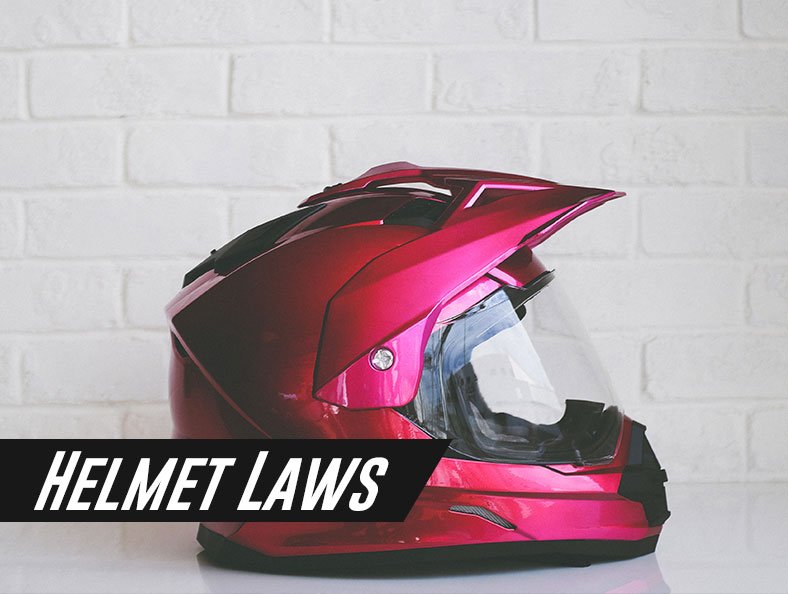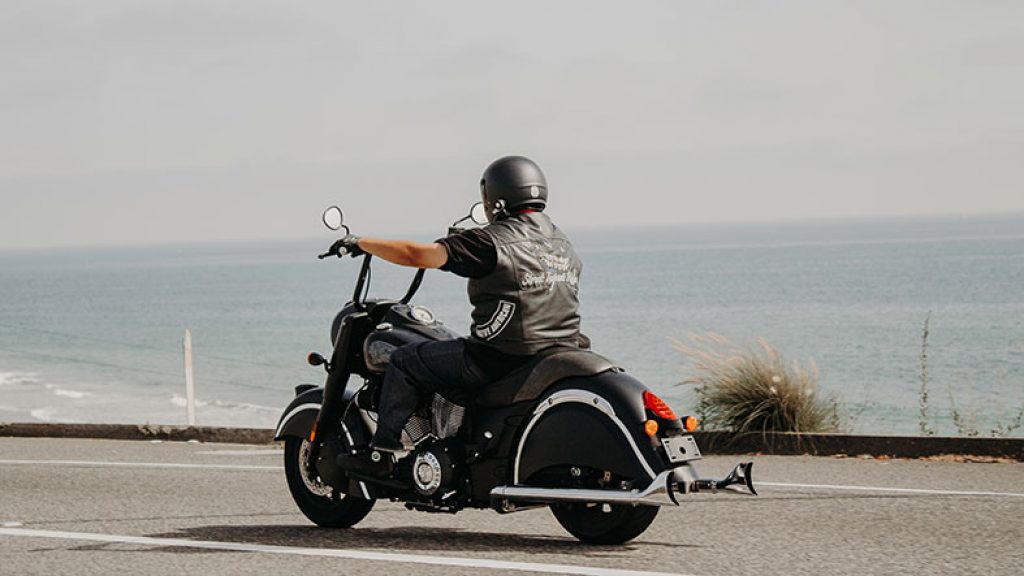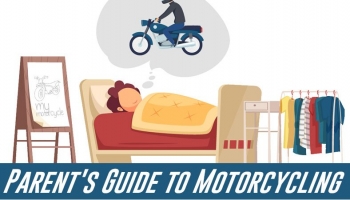Motorcycle Helmet Laws By State

Wearing a helmet is a good idea regardless of the distance and the bike you’re riding. It’s a game changer that’s also required by law in many countries across the world.
Helmet laws vary among the States, and they also change from time to time. For example, in some countries passengers don’t have to wear one, while in others there’s a universal law that requires all riders to wear one.
Before you get up on your bike, you should check what’s the law of the state you live in. If you’re riding to another state, you should check their laws too.
Be sure to check out motorcycle accident statistics so you can see just how important these regulations are.
Types of Regulations
There are two types of regulations – federal and state. These also vary and can change at any time. Both are equally as important, and you should know those that apply in the area you live in.
Federal
In the USA, the main federal regulation is that all helmets must meet and exceed a safety standard set out by the Department of Transportation. The current one is the DOT’s FMVSS 218 safety standard.
State
While all states must follow federal regulations, they can also set their own. This is important not only for the state you live in but for the state you’re passing through.
Read more about safety ratings.
Laws by State
As we said, the laws vary. Continue reading to learn about the requirements in your state as well as all others in the United States of America.
And to learn about different types of motorcycle helmets, click here.
Alabama
Alabama laws require all riders and passengers to wear a helmet. It has to have a hard exterior shell and a secured shock absorbing padding.
Alaska
If you’re 18 or older, you don’t have to have a helmet if you have a license to operate the motorcycle. All people who are younger than 18 are required to have one on at all times.

Arizona
Only those riders and passengers who are under 18 must have a helmet on in Arizona. However, all of them are required to have protective glasses, face shield, or goggles if the bike doesn’t have a protective windshield.
Arkansas
Passengers and riders under the age of 21 must have a helmet on in Arkansas. Everyone has to have goggles, protective glasses or transparent face shield. The law doesn’t apply to some motorcycles.
California
California requires passengers and riders to wear a helmet certified by the Department of Transportation. If you operate a three-wheeled vehicle that’s fully enclosed, you might not be required.
Colorado
Interestingly, adult passengers and drivers don’t have to have a helmet on in Colorado. Those under the age of 18 have to have one certified by DOT. Still, everyone has to have protective eyewear regardless of age.
Connecticut
Only people younger than the age of 18 aren’t allowed to ride on a bike or operate it without a helmet. These laws also change quite often so make sure to check with the Commissioner.
Delaware
People under the age of 19 are required to wear a helmet and eye protection. Riders and passengers older than the age of 19 must have it in their possession when riding.
Florida
Florida requires all operators and riders to wear protective helmets. It doesn’t apply if you’re over 21 and if your insurance policy provides for at least $10,000 in medical benefits. Everyone is required to have eye protection on.

Georgia
All riders and motorcycle operators must wear a helmet in the state of Georgia. Eye protection is also required if your bike doesn’t have a windshield.
Hawaii
People under the age of 18 can only ride on a bike or operate it if they’re got a safety helmet with a chin strap on. Riders over 18 don’t have to have it but are required to wear safety glasses or goggles.
Idaho
In Idaho, people under 18 are required to wear a helmet that meets the standard established by the Director of Motor Vehicles. These don’t apply if you operate the motorcycle on private property.
Illinois
You don’t have to dawn a helmet in Illinois regardless of whether you operate the bike or are riding as a passenger. The law requires everyone to ride with protective eyewear.
Indiana
The law requires drivers and riders younger than 18 to have helmets and protective eyewear on. You can use a transparent face shield or goggles as well.
Iowa
In Iowa, there’s no helmet law since 1976. Legislation to reinstate the law was proposed back in 2013.
Kansas
Riders under the age of 18 are required to have helmets and protective eyewear on. There was a universal law, but it was repealed in 1976.
Kentucky
In Kentucky, riders and passengers younger than the age of 21 are required to wear a helmet. Those that have a bike for less than a year and have an instruction permit also have to have one on.
Louisiana
Everyone who rides on a bike or operates it in Louisiana has to wear a helmet with a chin strap. The law is required at all times when the vehicle is in motion.

Maine
Everyone under the age of 18 has to wear a helmet regardless of whether they’re passengers or riders. Those with a permit license are required to as well.
Maryland
All passengers and drivers in Maryland must have a helmet on regardless of their age. Operators must also sport eye protection if the vehicle doesn’t have a windscreen.
Massachusetts
The law requires drivers and riders to have helmets on regardless of their age while riders must also wear protective eyewear. The law applies to people riding in a sidecar as well.
Michigan
Michigan riders are required to wear a helmet if they’re younger than 21. Those over 21 don’t have to if they had their license for at least two years or have security for the first-party medical benefits.
Minnesota
All operator and riders must wear a helmet if they’re younger than 18. Everyone with a permit license also must as well, regardless of their age. If you have a permit, you won’t be able to carry passengers.
Mississippi
Mississippi requires all riders and operators to wear a helmet approved by the American Association of Motor Vehicle Administrators.
Missouri
All people on a motorcycle must wear a helmet in Missouri while the vehicle is in motion. The headgear must meet the standards established by the Director of Motor Vehicles.
Montana
Passengers and operators younger than 18 years must wear protective headgear approved by the Montana Department of Justice.
Nebraska
Nebraska law requires passengers and drivers to wear a helmet with a chin strap. It also has to have padding and lining that exceeds federal regulations.

Nevada
Everyone on a bike in Nevada must wear appropriate headgear and protective eyewear when the vehicle is in motion. If the bike has a windscreen, protective eyewear isn’t required, but the headgear still is.
New Hampshire
Riders under 18 years must wear helmets although New Hampshire doesn’t have a law since the National Highway System Designation Act passed back in 1995.
New Jersey
All passengers and operators must wear a fitted helmet in New Jersey. It has to have a chin or neck strap that’s reflective on both sides. Protective eyewear is also required.
New Mexico
Everyone under 18 are required to wear a helmet in New Mexico. It has to be securely fastened and approved by the Director of Transportation.
New York
The law requires riders and drivers to wear helmets. Police authorities can issue permits that exempt people from wearing one in the case of public exhibitions or parades.
North Carolina
Passengers and operators must wear helmets with chin straps. The protective gear must be approved by the Department of Transportation in North Carolina.
North Dakota
Everyone under 18 must wear a helmet in North Dakota. All protective gear must comply with standards by the Department of Motor Vehicles.
Ohio
If you’re younger than 18 or hold a permit license, you have to have a helmet on in Ohio. All passengers and operators must have protective eyewear at all times while the vehicle is in motion.
Oklahoma
Riders and passengers under 18 must wear a helmet in the state of Oklahoma. It must feature padding, lining, and a chin strap.
Oregon
Everyone in Oregon who is riding on a bike or operating it must wear helmets approved by the U.S. Department of Transportation.

Pennsylvania
Riders older than 21 who have a license for at least two years and have completed a motorcycle rider safety course don’t have to wear a helmet. Those with a permit must wear it.
Rhode Island
Operators under 21 must wear a helmet in the state of Rhode Island. New operators must as well for one year after they got their license regardless of how old they are. Passengers must wear them at all times.
South Carolina
South Carolina requires all passengers and operators younger than 21 to wear a helmet. The protective headgear must be approved by the Department of Highways and Public Transportation.
South Dakota
Passengers and operators under 18 have to wear helmets that comply with federal regulations. Protective eyewear is also required at all times.
Tennessee
Drivers and riders must wear crash helmets that meet federal standards. If the driver or passenger is older than 21, the headgear has to meet federal motor vehicle safety standards.
Texas
All passengers and riders must wear helmets that meet the standards of the Department of Public Safety. Some exceptions can be made, so make sure to check with the Department of Public Safety.
Utah
Riders and operators in Utah must wear helmets if they’re younger than 18. The headgear must comply with the DOT’s standards.
Vermont
All drivers and passengers must wear a helmet in the state of Vermont. It must be approved by the Commissioner of the Department of Motor Vehicles.

Virginia
All passengers and operators must wear helmets when in Virginia. They must be approved by the Snell Memorial Foundation, Federal Department of Transportation or the American National Standards Institute.
Washington
Washington law requires passengers and operators to wear helmets with a chin or neck strap. Some exceptions can be made through you should check with the State Patrol for more information.
West Virginia
All passengers and operators must wear helmets in West Virginia. It has to have a neck or chin strap and be able to resist penetration and blows during impact. Everyone must also wear protective eyewear.
Wisconsin
All under age 18 or holding a permit must wear a helmet with a chin strap. Passengers and operators must wear protective eyewear regardless of age.
Wyoming
Only the passengers and operators under 18 must wear helmets in Wyoming. The headgear must comply with the standards of the state’s Superintendent of the Department of Transportation.
Other Considerations
How Helmets Impact Insurance
Wearing a helmet won’t directly impact your insurance rate, but it can reduce the cost of future premiums by preventing injuries.
Motorcycle insurance policies don’t have a factor related to helmet use. This is simply because no insurers can even prove whether you’re actually protecting yourself with a helmet or not. It’s up to you whether you’ll use on or not, even if it’s required by law in your state.
For this reason, insurers won’t ask you if you’re wearing it or not. However, using one can help you in more than one ways. Not only it protects you from potential injuries, but headgear might also prevent the cost of your premiums to rise.
The insurance claim related to medical treatment might not be as severe if you wear an appropriate model. You have to purchase motorcycle insurance every year, and wearing protective gear won’t affect the costs directly.
However, it reduces medical bills by preventing injuries. In turn, it also reduces how much your insurer raises the rates when you renew the insurance.
How Much Do They Cost?
The prices range from cheap and affordable to quite expensive. It all depends on the general style you opt for as well as the manufacturer. Additional features always mean increased price as well.
Other things might also affect the cost. A standard, DOT approved model usually costs around $125. Those that are approved by Snell, and have MIPS energy management and additional features cost around $500.
Qualities They Should Have
The first most important thing is to look for safety certification. Make sure it has at least the DOT certification if you can’t get the one approved by Snell. In most cases, the more certifications it has, the safer it is.
You should also consider the liner and padding and whether it suits the shape of your head and face. Make sure to get the right size as well, because a helmet is only protective when it’s well-fitted.
When to Replace
Even if your helmet doesn’t show any signs of breakage, it should be replaced every five years. It’s because manufacturers use different materials that deteriorate after a while. Resins and glues in the construction can only hold for so long especially when combined with the cosmetics and natural hair oils.
In most cases, you’ll drop the helmet or forget it out in the rain or sun at least once during those five years. All those events affect the durability and can impact performance after five years.
Conclusion
Hopefully, you found some valuable information on helmet laws in your states. We recommend you bookmark the list above just so you can always return to it when planning a trip.
Keep in mind that all of the laws above are subject to change. They change regularly from time to time, so it’s always the best to check with the state officials on whether they have changed or not.
Of course, we advise you to consider wearing a helmet at all times regardless of the law in your state. It’s an easy-to-use piece of your protective gear that can prevent otherwise fatal injuries.






